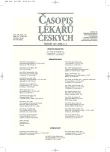Purkynje Fibers of the Heart Conduction System – History and the Present Time
Purkyňova vlákna převodního systému srdce – historie a současnost Purkyňových objevů
Od publikace Purkyňových převodních vláken v srdci v Archiv f. Anatomie u. Physiologie uběhlo 160 let a 166 let od publikace, která byla napsána v polské verzi. Již za života Purkyněho byla řadou anatomů morfologie těchto vláken rozpracována. V té době nikdo ještě netušil, jak obrovský fyziologický a klinický dopad tento objev bude pro medicínu mít. To ukázalo teprve 20. století a ukazuje i začátek současného století. Purkyněho práce spustila kaskádu objevů, které se staly na začátku minulého století podkladem formulace základního schématu převodního systému. Purkyňova vlákna – Purkyňovy kardiomyocyty – jsou součástí celého komplexu převodní srdeční soustavy, která je dnes zařazena pod pojem specializované svalové tkáně odpovědné za generování srdečních vzruchů. Z tohoto hlediska a z hlediska ultrastruktury jsou buňky různých části srdečního převodního systému v určitých morfologických rysech podobné. Oproti kontraktilním buňkám pracovní srdeční svaloviny mají buňky převodního systému včetně Purkyňových vláken málo myofibril, menší množství malých mitochondrií, a tím světlou cytoplazmu. T tubulární systém chybí, nebo je velmi nepatrně vytvořen. Buňky obsahují větší množství glykogenu. Dají se znázornit některými histochemickými metodami. Nejsou však zcela uniformní, liší se svou velikostí v jednotlivých částech převodní soustavy, dále přítomností či nepřitomností interkalárních disků, mnořstvím nexusů-gap junkcí a ještě jinými znaky. Nicméně tyto specializované buňky jsou si značně morfologicky podobné a pracují jako celek. Výzkum Purkyňových srdečních vláken v posledních desetiletích je orientován na jejich ultrastrukturu, histochemická a genetická bádání včetně budoucí genetické léčby poruch převodního systému – arytmie a nahrazení elektrického pacemakeru pacemakerem biologickým. Kdyby Jan Evangelista Purkyně žil, byl by jistě překvapen, ale i potěšen, do jakého vědeckého stupně a šíře včetně klinické aplikace došel jeho původní objev.
Klíčová slova:
Purkyňova vlákna, morfologie, historie, současnost.
Authors:
O. Eliška
Authors‘ workplace:
Anatomický ústav 1. LF UK, Praha
Published in:
Čas. Lék. čes. 2006; 145: 329-335
Category:
History of Medicine
Overview
It has been 160 years now since Purkynje published the finding of conduction fibers in the heart in Archiv f. Anatomie u. Physiologie and it has been 166 years since his publication in polish version. Already during Purkynje’s life, some anatomists had solved the morphology of these fibers but nobody at that time knew of what great physiological and medical importance this discovery would be for medicine. It was seen as late as in the 20th century and in contemporary times. Purkynje’s work indicated the cascade of these discoveries, which were leading in the beginning of the previous century to the formulation of the basic scheme of the conduction system. Purkynje fibers or Purkynje cardiomyocytes are part of the whole complex of the cardiac conduction system which today is classified as specific heart muscle tissue, being responsible for the generation of the heart impulses. From the point of view of ultrastructural composition, the cells of different parts of the cardiac conduction systém are partly similar. In contrast to the heart contractile cardiomyocytes, the cells of the cardiac conduction systém including Purkynje fibers have a small amount of myofibrils,small mitochondrias, light cytoplasm and a higher glycogen content, but no T-tubular system. They can be detected with some morphological methods. Nevertheless the cells of the conduction system are not completely uniform. They differ in size, number of nexuses-gaps and intercalar discs in individual parts of the conduction systém. Nevertheless, these specialized cells work as a whole – unit. Nowadays, the morphology research of all the parts of cardiac conduction system, including Purkynje fibers, is focused on ultrastructural, histochemical and genetical problems. The question is, wheather with future gene/cell therapy disturbances of the conduction system such as arrythmias, can be prevented and cured by replacing the electrical pacemakers with biological ones. If Jan Evangelista Purkynje lived today, he would be surprised but surely delighted with the high degree of research concerning his discovery and its clinical application.
Key words:
Purkynje fibers, morphology, history, present time.
Labels
Addictology Allergology and clinical immunology Angiology Audiology Clinical biochemistry Dermatology & STDs Paediatric gastroenterology Paediatric surgery Paediatric cardiology Paediatric neurology Paediatric ENT Paediatric psychiatry Paediatric rheumatology Diabetology Pharmacy Vascular surgery Pain management Dental HygienistArticle was published in
Journal of Czech Physicians

- Advances in the Treatment of Myasthenia Gravis on the Horizon
- Metamizole at a Glance and in Practice – Effective Non-Opioid Analgesic for All Ages
- Possibilities of Using Metamizole in the Treatment of Acute Primary Headaches
- Metamizole in perioperative treatment in children under 14 years – results of a questionnaire survey from practice
- The Importance of Limosilactobacillus reuteri in Administration to Diabetics with Gingivitis
Most read in this issue
- Purkynje Fibers of the Heart Conduction System – History and the Present Time
- Larva migrans cutanea
- Pulmonary Endarterectomy – The Surgical Treatment of Chronic Thromboembolic Pulmonary Hypertension
- Long-lasting Cardiostimulation in the Treatment of Heart Failure
